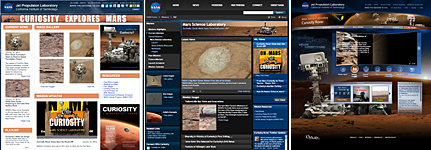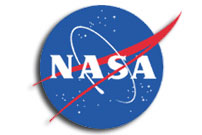NASA is Unable (and Unwilling) To Coordinate Its Websites

 Keith’s note: At bottom of this release “Mars Rover Teams Dub Sites in Memory of Bruce Murray“, JPL has included “For more information about Opportunity, visit http://www.jpl.nasa.gov/msl , http://www.nasa.gov/rovers and http://marsrovers.jpl.nasa.gov . For more information about Curiosity, visit http://www.nasa.gov/msl and http://mars.jpl.nasa.gov/msl“ .
Keith’s note: At bottom of this release “Mars Rover Teams Dub Sites in Memory of Bruce Murray“, JPL has included “For more information about Opportunity, visit http://www.jpl.nasa.gov/msl , http://www.nasa.gov/rovers and http://marsrovers.jpl.nasa.gov . For more information about Curiosity, visit http://www.nasa.gov/msl and http://mars.jpl.nasa.gov/msl“ .
Two missions – five websites.
First for the Opportunity links. if you go to http://www.jpl.nasa.gov/msl/ you do not get anything on Opportunity but rather its a Curiosity page. If you go to http://marsrovers.jpl.nasa.gov it redirects you to http://marsrovers.jpl.nasa.gov/home/index.html at JPL. If you go to http://www.nasa.gov/rovers it redirects you to http://www.nasa.gov/mission_pages/mer/index.html at NASA HQ. If you go to the NASA HQ rover site it has a link to a JPL rover website at http://marsrover.nasa.gov/home/index.html it does not link to http://marsrovers.jpl.nasa.gov. And http://marsrovers.jpl.nasa.gov is identical to http://marsrover.nasa.gov/home/index.html. So, one of the three links listed has nothing to do with Opportunity. The NASA HQ MER site links to a JPL MER site but it is at a different address than the JPL MER website listed in the release even though the content is identical.
Now for the Curiosity links. If you go to http://www.nasa.gov/msl it redirects you to http://www.nasa.gov/mission_pages/msl/index.html at NASA HQ. If you go to http://mars.jpl.nasa.gov/msl you end up at a MSL website at JPL. The NASA HQ MSL site points to the JPL MSL site but the JPL MSL site does not point to the NASA HQ MSL site.
So, NASA is paying to maintain two MSL websites and the web addresses they give out are different than the actual web addresses – but they won’t bother to put the actual addresses in press releases. Meanwhile, NASA is paying for 2 (or 3) MER websites – and again the links put in the press release are not the actual website address. And a website link that has “MSL” in it is listed as a place to get MER information. In total 5 links are included for 2 missions – and JPL PAO seems to think this is just fine. Meanwhile NASA PAO and SMD have the nerve to moan and complain about lack of education and public outreach funds? They are squandering their money on overlapping websites that don’t even coordinate their content or links. I have raised this issue at several SMD media telecons. All they say is “we’ll look into it”. They don’t. They just don’t care about being efficient or coordinating. No – they just want more money and refuse to change the way that they operate. Clueless.
Oh yes — did you know that NASA’s Constellation Program is building the Altair Lunar Lander that will land on the moon by 2020? Moreover, the Altair will be launched on the Ares V rocket. HEOMD has an incredibly tangled web presence too.
– Why Does NASA Maintain Three (Four) Different MSL Websites?
– Why does NASA need multiple websites for the same mission?, earlier post
– NASA’s Tangled Human Spaceflight Web Presence, earlier post
– NASA’s Sprawling Web Presence, earlier post
– NASA’s Inability To Speak With One Voice Online, earlier post








Yes. I agree. All the web sites make a mess and confusion of a great mission.
Disagree, prefer many sites. They can have different content and target different audiences.
NASA outreach is generally hell-bent on addressing the public at an 8th grade level. Dumb it down and strip technical details. Because scientists and engineers can’t communicate with average people without average people having to think, the story goes.
The mind-set among communication professionals is that must be avoided even though it is totally misleading the public as to what science is and how it is done. (“But that’s OK because we’ll run pieces that laboriously explain the scientific method and explain what “hypotheses” are…that will really get people into it…especially if we fully deploy it across Social Media! “)
Allowing many sites permits a wider range of content without bothering anyone (except NASAWATCH).
If the model is centralized control, the dumb-it-down to lowest-common-denominator people will win and we’ll get one site with smiley face buttons for kids and elaborate explanations of what a planet is and endless contests about naming a crater and sending a postcard to Curiosity, no doubt via Twitter.
With many sites, you can always have some instrument team popping up with a useful site unfiltered by outreach specialists. And those are genuine data sources that will inspire true interest and create future NASA employees, not click-here-and-send-postcard-to-Curiosity.
Some of the most fascinating NASA sites have no front-end, just an FTP directory …
You seem to be operating under the assumption that there are multiple sites for one mission so as to better cover the mission. Untrue. There are multiple websites because the agency has turf wars and one group or center cannot or will not cooperate with another. The net result is that the agency pays for duplicate websites. Indeed, NASA policy is that there is only supposed to be one website permission but NASA HQ is unwilling and unable to enforce its own rules.
They could do this with different areas of one site. Have one area particularly for the non-technical (“dumbed down”) outreach stuff and make the front page agnostic enough of technical level. Or have a 1-2-3 technical level rating on the articles and interviews etc. Make access easy, people can decide what they can digest.
If there was a clear strategic plan in place where different audiences were targeted then I’d be cool with that. But this is not what is happening here. JPL does whatever they want and even though NASA pays the bills JPL can do as they please. Same thing goes on with other centers, mission directorates etc. When I post rants like this PAO, mission directorates, and center staff all send me emails privately that agree with what I have written. The problem is simple: NASA’s governance model is one that sets up rules but has no consequences for ignoring the rules. Since there is no downside to ignoring the rules people ignore the rules because they can.
This makes it seem like perhaps the PAO people and center staffs are not in fact in control of this situation (if they’re agreeing with you but not taking any action). It may be more effective to try finding out who actually is calling the shots and go after him/her specifically.
Not sure why you’re worried about simple addresses that expand out to the full URL of the index page when you get there. That is usually the case. The simple addresses are easier to read.. It’s not like they’re taking you to a totally different place than they represent.
The reason why they use redirect is that PAO refuses to use the actual URLs and it is easier to tell the servers to redirect than to communicate with PAO. My sources on this are at NASA.
I am pretty sure I stumbled across the Ark of the Covenant while navigating the twisted tangled mess that is the nasa website structure. the worse was during shuttle as there was cool info on spaceflight.nasa.gov but nobody ever talked about that site nor the the public know how to find stuff on there.
Although the maze of multiple websites may be frustrating there is a beneficial silver lining — if we have the patience necessary to wade through them all, we can choose and save (or bookmark) the URLs that best fits our desired level.